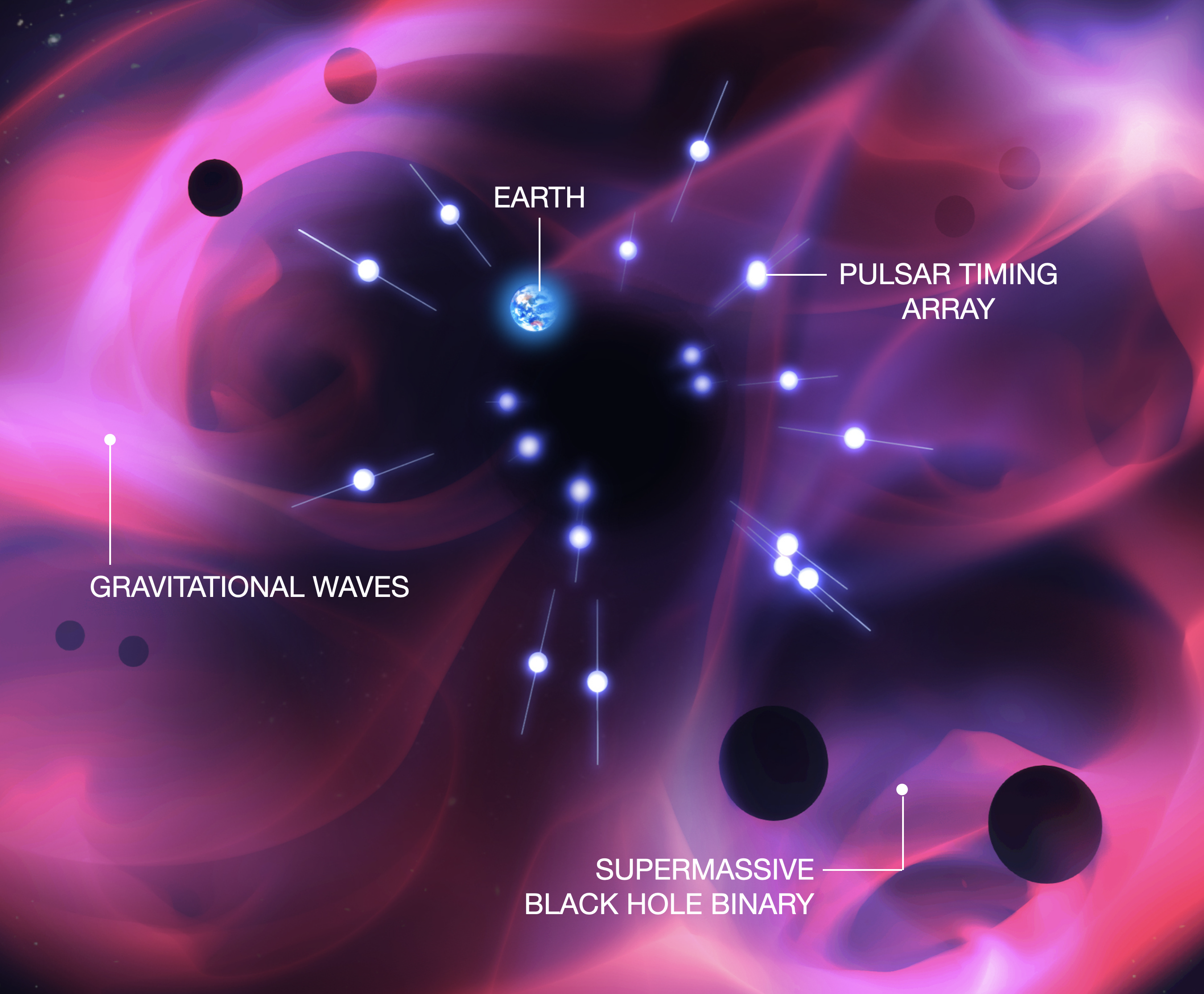World-wide Radio Telescope Network Strengthens Evidence for Signal that May Hint at Ultra-Low Frequency Gravitational Waves
An international team of astronomers has announced the results of a comprehensive search for a background of low-frequency gravitational waves (GWs). These light-year-scale ripples, a consequence of general relativity, permeate all of spacetime and could originate from mergers of the most massive black holes in the Universe or from events occurring soon after the formation of the Universe in the Big Bang.
The International Pulsar Timing Array (IPTA), which joins the work of several astrophysics collaborations from around the world, recently completed its search for GWs in their most recent official data release, known as Data Release 2 (DR2). This data set consists of precision timing data from 65 millisecond pulsars – stellar remnants which spin hundreds of times per second, sweeping narrow beams of radio waves that appear as pulses due to the spinning – combined from independent data sets of the European Pulsar Timing Array (EPTA), the North American Nanohertz Observatory for Gravitational Waves (NANOGrav), and the Parkes Pulsar Timing Array in Australia (PPTA), the three founding members of the IPTA.

This search includes an extensive comparison between individual data sets from the large regional scientific collaborations and the combined data set. The GW search of the IPTA DR2 has revealed strong evidence for a low-frequency signal detected by many of the pulsars in the combined data. The characteristics of this common-among-pulsars signal are in broad agreement with those expected from a GW “background” (GWB). This background is formed by many different overlapping GW signals emitted from the cosmic population of supermassive binary black holes (i.e., two supermassive black holes orbiting each other and eventually merging), analogous to background noise from the many overlapping voices in a crowded hall. This result further strengthens the gradual emergence of similar signals that have been found in the individual data sets of the participating collaborations over the past few years.
“This is a very exciting signal! Although we do not have definitive evidence yet, we may be beginning to detect a background of gravitational waves,” says Dr. Siyuan Chen, a member of the EPTA and NANOGrav, and the leader of the IPTA DR2 search and publication. Dr. Boris Goncharov from the PPTA cautions on the possible interpretations of such common signals: “We are also looking into what else this signal could be. For example, perhaps it could result from noise that is present in individual pulsars’ data that may have been improperly modeled in our analyses.”
To identify the GWB as the origin of the low-frequency signal, the IPTA must also detect spatial correlations between pulsars; this means that each pair of pulsars must respond in a very particular way to the GWs, depending on their separation on the sky. These signature correlations between pulsar pairs are the “smoking gun” for a GWB detection – without them, it is difficult to prove that some other process is not responsible for the signal. Intriguingly, the first indication of a GWB would be a common signal like that seen in the IPTA DR2. Whether or not this spectrally similar low-frequency signal is correlated between pulsars in accordance with the theoretical predictions for a gravitational-wave background will be resolved with further data collection, expanded arrays of monitored pulsars, and continued searches of the resulting longer and larger data sets.
Consistent signals like the one recovered with the IPTA analysis have also been published in individual data sets more recent than those used in the IPTA DR2, from each of the three founding collaborations. The IPTA DR2 analysis demonstrates the power of the international combination giving strong evidence for a GWB compared to the marginal or absent evidences from the constituent data sets. Additionally, new data from the MeerKAT telescope and from the Indian Pulsar Timing Array (InPTA), the newest member of the IPTA, will further expand future data sets. “The first hint of a GWB would be a signal like that seen in the IPTA DR2. Then, with more data, the signal will become more significant and will show spatial correlations, at which point we will know it is a GWB. We are very much looking forward to contributing several years of new data to the IPTA for the first time, to help achieve a GWB detection,” says Dr. Bhal Chandra Joshi, a member of the InPTA.
Given the latest published results from the individual groups who now all can clearly recover the common signal, the IPTA is optimistic for what can be achieved once these are combined into the IPTA Data Release 3. Work is already ongoing on this new data release, which at a minimum will include the latest data sets from the four constituent PTAs of the IPTA; the GWB analysis of DR3 is expected to be completed within the next few years. Dr. Maura McLaughlin of the NANOGrav collaboration says, “If the signal we are currently seeing is the first hint of a GWB, then based on our simulations, it is possible we will have more definite measurements of the spatial correlations necessary to conclusively identify the origin of the common signal in the near future.”